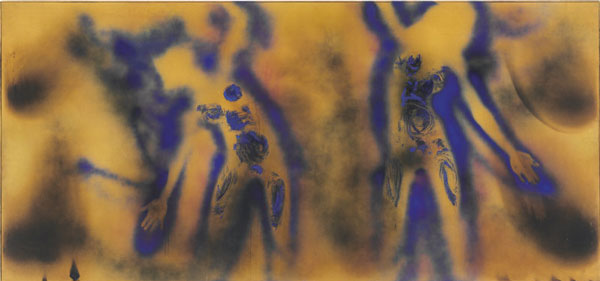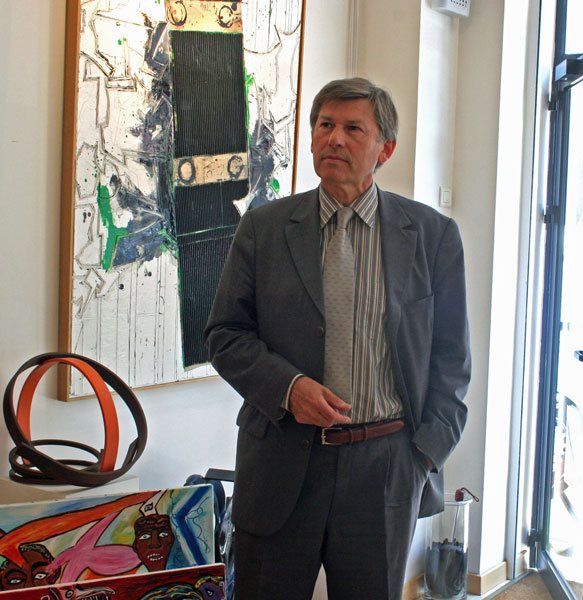| FC 1 is considered to be one of the most important Post War European works of art.
FC 1 is poised to break the world record for the artist at auction.
FC 1 was realized in 1962, the year of Klein’s untimely death at age 34, after a short 7 year career.
Estimated $30-40 million, this work situates Klein within the elite circle of the most expensive Post-War artists.
FC 1 combines each of the artist’s major strengths and philosophical ideas. All of the artist’s signature elements are included: fire, anthropometry, International Klein Blue, and pink pigment.
Auction 8 May 2012 Christie’s New York - 20 Rockefeller Plaza
Viewing Paris 6 April 2012 Christie’s - 9 avenue Matignon
Geneva 16-17 April 2012 Société Nautique Geneva, Port Noir, Cologny
New York 4-8 May 2012 Christie’s - 20 Rockefeller Plaza
Related Sale Sale 2557
Post-War and Contemporary Evening Sale
05/08/2012
New York, Rockefeller Plaza
Related Departments Post-War & Contemporary Art
New York – Fifty years after the artist’s death, Christie’s is proud to announce the upcoming auction of Yves Klein’s legendary Fire-Color Painting FC 1, as the highlight of the Post War and Contemporary Art Evening Sale on May 8. Executed a few weeks before his premature death, at the age of 34, FC 1 is widely acclaimed as his ultimate masterpiece. One of the most important works of Post-War European art to come to the market , FC1 acquired an iconic status soon after the release of Klein’s movie, La Revolution Bleue, where the celebrated recording of the painting’s creation inscribed FC 1 in the 20th Century collective memory. With the creation of FC 1, Klein pushed the concept of the heroic artist to a new level. As an alchemist manipulating the highly volatile elements of gas and fire, Klein created a work that represents the epitome of what he called “dangerous paintings”, where Klein risked his life and the life of his models. Privately owned, FC 1 has been featured prominently in all of his major retrospectives, including those held at the Guggenheim Museum in New York and the Hirshhorn Museum in Washington DC.
A portion of the proceeds of the sale will be donated to OCEANA, the largest international organization working solely to protect the world’s oceans.
“Oceana is very grateful to be a part of this opportunity, and it is beautiful to see that fifty years after his death, Yves Klein is now giving back to the oceans through his work” commented Andy Sharpless, Oceana CEO. “Now the oceans are in trouble. People everywhere are stepping up to restore and protect them. This partnership with Christie’s is a perfect example of the kind of creative thinking that helps produce the policy changes that will save the oceans.”
Untitled (FC 1)
“Yves Klein’s FC 1 is to Europe what Pollock’s NUMBER ONE is to America. It is the ultimate heroic work fusing all of the elements that Klein learnt to master over his short and intense career. FC1 perfectly embodies Klein’s obsession with the irreconcilable concept of presence and absence, life and death; this painting took an enormous emotional and physical toll on the artist. FC1 was Klein’s last, but perhaps most poignant feat as an artist, and is expected to break the record for any Post War European work of art.” stated Loic Gouzer, International Specialist, Post-War and Contemporary Art.
“This painting, which for me is his absolute masterpiece, came close to not existing. The session was over; he had exhausted all his strength and was sitting down wiping off his sweat and trying to resume his normal breathing. In the left-hand corner of the studio I pointed out a panel which Yves had forgotten. The fire had to be rekindled and the models watched, fascinated as we all were, as Yves completed this masterpiece, arguably the greatest of his career and I am convinced of the 20th Century. I felt guilty about this for years afterwards, I should have told him to stop. I felt responsible for what happened a few weeks later.” (Yves Klein died in June 1962 at the age of 34) wrote Rotraut Klein-Moquay in March 2012, in a personal account to Loic Gouzer
“The feeling was even stronger when we worked at the ‘Gaz de France’; the atelier was cold, huge, and draughty, bitter winter in Paris. The hard physical conditions in close contact with the primeval elements, fire and water, turned the experience into a veritable rite of passage. I feel that these experiences were somehow crucial in my development as someone involved in creation.” remembers Elena Palumbo-Mosca, Yves Klein’s favorite model.
FC 1 depicts the ethereal images of two female figures seemingly dancing or rising amid the fiery blue, gold and red flame-licked surface. The bodies hover on the borderline of abstraction, between the realms of the material and the immaterial. For Klein, this was the pictorial expression of the auspicious moment of transcendence or transmutation, seen as a kind of ritualistic and celestial dance of figures into an abstract realm. Indeed, in FC 1 the demonstrably joyous physical essences of the youthful figures seem like angels in the fiery void, at the very same time that their immutable imprints remain materially assertive on the shimmering surface of the picture.
The Place of FC 1 in Klein’s Career
The idea of performance became increasingly central during Klein’s tragically brief 7 year career, during which he strived to liberate the senses from their earthly limits in order to intensify our experience of life. From the grand curtains that draped the entrance to his early exhibitions at the Galerie Iris Clert in Paris, to the grand performances of his Anthropometry works, the idea of spectacle became more and more important.
This level of theatricality intensified beginning in March 1961 with the creation of his Fire paintings, for which he was permitted to use the equipment in the testing center of Gaz de France at the Plaine Saint-Denis. Klein ensured that TV crews, press photographers and reporters were present to capture the event.
In the first Fire paintings, Klein attempted only to capture traces of the flame itself. Soon, he began to attempt to capture a similar momentary trace of what he believed to be the indestructible essence of human life in a number of Fire paintings that made use of his “Anthropometric” technique of capturing the imprints and silhouettes of the nude human form.
Klein went on to the Fire-Color series in autumn 1961, spraying and blowing blue and pink pigment onto the gold surface of the specially fabricated fire-resistant board that he had used for the Fire paintings. FC 1 is the only work in Klein’s Fire-Color series to incorporate the “Anthropometric” outlines of bodies.
The Making of FC 1
Rotraut Klein-Moquay remembers: “Yves had received the panels which he had carefully framed. They were enormous and very heavy. Their transportation had to be organized, the models hired: Elena, Gilles; the photographers: Pierre Joly and Véra Cardot, the cameraman, the artist Alex Kosta as the fireman, and some assistants for the handling. The setting in that industrial warehouse was surreal; the cold, the water, and the noise of the flame-thrower which Yves manipulated with apparent ease, even though it weighed over eighty pounds.”
For FC 1, Klein hired two models to act as his “brushes.” In the first step of the creative process, the models were doused with water and under Klein’s direction pressed themselves onto the large sheet of specially treated cardboard. Once the models had left their positions, Klein, using a large torch-like device, directed an intense flame toward the board, charring parts of the surface. Where the models had pressed against the surface, the moisture-soaked cardboard resisted the scorching effect of the flames, leaving ghostly apparitions of the bodies hovering on the picture plane.
Klein also used water to create pictorial effects, interweaving splashes, spots and drips in the layers of the image.
For the next step, the models coated themselves lightly with a subtle pink paint, which left delicate impressions of their breasts and thighs as they pressed against the surface of the board. Finally, Klein instructed the models to apply a thicker coat of his IKB pigment to leave a last impression on the surface, while he enhanced their silhouettes by spraying both pink and blue pigment onto the work with an airbrush.
In this way, the work was created without any direct touch from the artist. Since the era of the cave painters, artistic practice had always been defined by the act of making a mark on a surface.
The Meaning of FC 1
FC 1 represents the pinnacle of Yves Klein’s career, both chronologically and spiritually. As Pierre Restany, the critical authority on Yves Klein and Post war European art, noted that Fire-Color painting constitutes "the culmination of Yves Klein's artistic practice and the pure classicism of his pictorial style."
By placing the sensual apparitions of the female body among the flame bursts and smoke shadows, Klein combined life and death in a way that speaks to the fragility of life but also to its permanence. On the one hand, there is a clear sense of the destructive power of the flame. On the other, the presence of the female forms hints at the eternal power of life that transcends all things. All of the forms are surrounded in the mystical trinity of colors that held special significance for the deeply religious Klein, symbolizing the Father/Sun (gold), the Son/water (blue) and the Holy Spirit/ Divine Blood (red). Klein set daily life into the context of the spiritual realm he called the void; a void marked by the primal, eruptive, apocalyptic and eternal forces of life-giving and life-consuming energy. As he stated, “The void has always been my main preoccupation, and I firmly believe that fires burn in the heart of the void as in the heart of man.”
About Christie’s
Christie’s, the world's leading art business, had global auction and private sales in 2011 that totaled £3.6 billion/$5.7 billion. Christie’s is a name and place that speaks of extraordinary art, unparalleled service and expertise, as well as international glamour. Founded in 1766 by James Christie, Christie's has since conducted the greatest and most celebrated auctions through the centuries providing a popular showcase for the unique and the beautiful. Christie’s offers over 450 auctions annually in over 80 categories, including all areas of fine and decorative arts, jewellery, photographs, collectibles, wine, and more. Prices range from $200 to over $100 million. Christie's also has a long and successful history conducting private sales for its clients in all categories, with emphasis on Post-War and Contemporary, Impressionist and Modern, Old Masters and Jewellery. Private sales totaled £502 million / $808.6m in 2011, an increase of 44% on the previous year.
Christie’s has a global presence with 53 offices in 32 countries and 10 salerooms around the world including in London, New York, Paris, Geneva, Milan, Amsterdam, Dubai, Zürich, and Hong Kong. More recently, Christie’s has led the market with expanded initiatives in growth markets such as Russia, China, India and the United Arab Emirates, with successful sales and exhibitions in Beijing, Mumbai and Dubai.
*Estimates do not include buyer’s premium. Sales totals are hammer price plus buyer’s premium and do not reflect costs, financing fees or application of buyer’s or seller’s credits.
Complete catalogue available online at http://www.christies.com/ or via Christie’s Mobile, iPhone, iPad and Android apps.
About Oceana
Oceana is the largest international advocacy group working solely to protect the world’s oceans. Oceana wins policy victories for the oceans using science-based campaigns. Since 2001, we have protected over 1.2 million square miles of ocean and innumerable sea turtles, sharks, dolphins and other sea creatures. More than 500,000 supporters have already joined Oceana. Global in scope, Oceana has offices in North, South and Central America and Europe. To learn more, please visit www.oceana.org
Visit Christie’s Website at www.christies.com
Complete catalogue available online at www.christies.com
|



